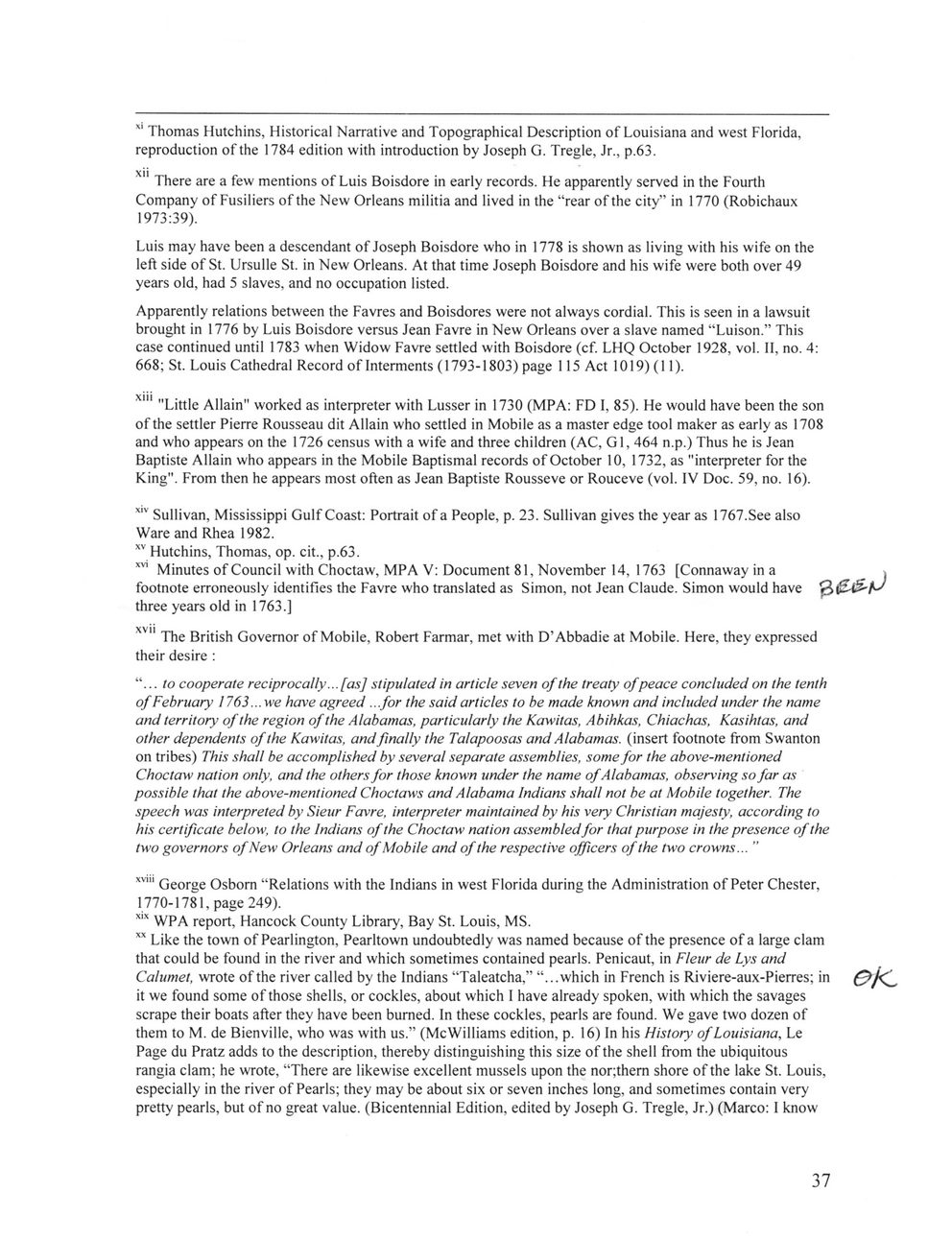This text was obtained via automated optical character recognition.
It has not been edited and may therefore contain several errors.
X1 Thomas Hutchins, Historical Narrative and Topographical Description of Louisiana and west Florida, reproduction of the 1784 edition with introduction by Joseph G. Tregle, Jr., p.63. xii There are a few mentions of Luis Boisdore in early records. He apparently served in the Fourth Company of Fusiliers of the New Orleans militia and lived in the ?rear of the city? in 1770 (Robichaux 1973:39). Luis may have been a descendant of Joseph Boisdore who in 1778 is shown as living with his wife on the left side of St. Ursulle St. in New Orleans. At that time Joseph Boisdore and his wife were both over 49 years old, had 5 slaves, and no occupation listed. Apparently relations between the Favres and Boisdores were not always cordial. This is seen in a lawsuit brought in 1776 by Luis Boisdore versus Jean Favre in New Orleans over a slave named ?Luison.? This case continued until 1783 when Widow Favre settled with Boisdore (cf. LHQ October 1928, vol. II, no. 4: 668; St. Louis Cathedral Record of Interments (1793-1803) page 115 Act 1019) (11). xm "Little Allain" worked as interpreter with Lusser in 1730 (MPA: FD I, 85). He would have been the son of the settler Pierre Rousseau dit Allain who settled in Mobile as a master edge tool maker as early as 1708 and who appears on the 1726 census with a wife and three children (AC, Gl, 464 n.p.) Thus he is Jean Baptiste Allain who appears in the Mobile Baptismal records of October 10, 1732, as "interpreter for the King". From then he appears most often as Jean Baptiste Rousseve or Rouceve (vol. IV Doc. 59, no. 16). XIV Sullivan, Mississippi Gulf Coast: Portrait of a People, p. 23. Sullivan gives the year as 1767.See also Ware and Rhea 1982. xv Hutchins, Thomas, op. cit., p.63. ? Minutes of Council with Choctaw, MPA V: Document 81, November 14, 1763 [Connaway in a ( footnote erroneously identifies the Favre who translated as Simon, not Jean Claude. Simon would have three years old in 1763.] xvn The British Governor of Mobile, Robert Farmar, met with D?Abbadie at Mobile. Here, they expressed their desire : ?... to cooperate reciprocally... [as] stipulated in article seven of the treaty of peace concluded on the tenth of February 1763...we have agreed ...for the said articles to be made known and included under the name and territory of the region of the Alabamas, particularly the Kawitas, Abihkas, Chiachas, Kasihtas, and other dependents of the Kawitas, and finally the Talapoosas and Alabamas. (insert footnote from Swanton on tribes) This shall be accomplished by several separate assemblies, some for the above-mentioned Choctaw nation only, and the others for those known under the name of Alabamas, observing so far as possible that the above-mentioned Choctaws and Alabama Indians shall not be at Mobile together. The speech was interpreted by Sieur Favre, interpreter maintained by his very Christian majesty, according to his certificate below, to the Indians of the Choctaw nation assembledfor that purpose in the presence of the two governors of New Orleans and of Mobile and of the respective officers of the two crowns... ? xvm George Osborn ?Relations with the Indians in west Florida during the Administration of Peter Chester, 1770-1781, page 249). XIX WPA report, Hancock County Library, Bay St. Louis, MS. xx Like the town of Pearlington, Pearltown undoubtedly was named because of the presence of a large clam that could be found in the river and which sometimes contained pearls. Penicaut, in Fleur de Lys and Calumet, wrote of the river called by the Indians ?Taleatcha,? ?...which in French is Riviere-aux-Pierres; in e>K it we found some of those shells, or cockles, about which I have already spoken, with which the savages scrape their boats after they have been burned. In these cockles, pearls are found. We gave two dozen of them to M. de Bienville, who was with us.? (McWilliams edition, p. 16) In his History of Louisiana, Le Page du Pratz adds to the description, thereby distinguishing this size of the shell from the ubiquitous rangia clam; he wrote, ?There are likewise excellent mussels upon the northern shore of the lake St. Louis, especially in the river of Pearls; they may be about six or seven inches long, and sometimes contain very pretty pearls, but of no great value. (Bicentennial Edition, edited by Joseph G. Tregle, Jr.) (Marco: I know 37

Favre The-Favre-Family-in-Hancock-County-37